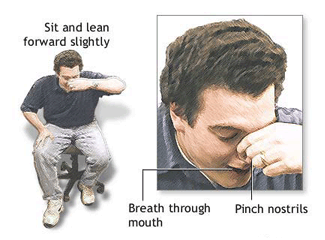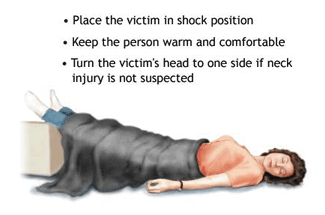Depending on the severity, a head injury may be evidenced by a visible wound, swelling, nasal discharge, or even loss of consciousness. And although most minor head injuries caused by a fall or a strike to the head may result in a bruise or a bump and are not dangerous, it is extremely important to pay close attention to the following symptoms:
- Excessive bleeding from an open wound
- Loss of consciousness
- Interruption of breathing
- Prolonged disorientation or apparent memory loss
If you observe any of the above, the victim may have sustained serious head trauma and will require professional medical attention and you need to dial 9-1-1 immediately. Until the ambulance arrives:
- If possible, place the victim in a dim, quiet area.
- Lay the victim down with his head and shoulders slightly elevated.
- If the wound is bleeding, dress it with gauze or clean cloth.
- Do not leave the victim unattended.
- If the victim loses consciousness, you may need to perform CPR.
If the injury does not appear serious or extend beyond minor bruising, it should be treated accordingly.
Fainting is a brief period of time – usually less than a minute – when a person loses consciousness and becomes unresponsive. Before fainting they will usually complain of dizziness or “light-headedness”.
- if someone is dizzy and you suspect they may faint, provide support as you help them to the ground or floor. If their condition doesn’t improve or becomes worse, call 911.
- if you’ve witnessed someone faint and they remain unresponsive, call 911, and be prepared to administer CPR
A sudden spike in high blood sugar (hyperglycemia) or dip in low blood sugar (hypoglycemia) can result in fainting in some individuals with diabetes or other underlying conditions. Hyper- or hypoglycemia may be caused by poor dietary intake, sudden unusual physical exertion, excessive insulin, etc. but medications like insulin are designed to maintain appropriate levels of blood sugar.
Signs of low blood sugar:
- extreme lethargy
- confusion
- excessive thirst
- weakness
- drowsiness
Have the victim drink something sugary – fruit juice, cola, etc – to quickly raise their blood sugar levels. If they do not improve within 10 minutes, call 911 and continue to monitor until EMS arrives.
A human nose is rich with small fragile blood vessels which are susceptible to damage. A nosebleed may be caused by a fall, a strike to the nose, or even from breathing excessively dry air.
If the nosebleed is not a symptom of a more serious injury, it is rarely dangerous and can usually be stopped by applying continuous pressure.

- Do NOT tilt the victim’s head backward.
- Have the victim sit or stand upright to slow down the flow of blood.
- Loosen any tight clothing around the victim’s neck.
- If possible, have the victim spit out excess saliva – swallowing may disturb the clot and cause nausea.
- Pinch the nostrils shut and press the tip of the nose against the bones of the face.
- Maintain pressure for 5 to 10 minutes.
- Once the bleeding has stopped, the victim should avoid blowing his nose or otherwise straining himself for at least an hour.
Poisons are any substances which act to produce harmful effects on the normal body process. The major means of poisons entering the body are through ingestion (eating or drinking), inhalation (through the nose and mouth), injection (body tissue or blood stream), and topical absorption (through the skin).
Poisoning by ingestion
Poisoning by ingestion may be caused by intentional or accidental overdose of medication such as drugs and alcohol; household cleaners or chemicals; and spoiled food products.
The signs and symptoms of poisoning by ingestion are:
- nausea, vomiting, and diarrhea
- severe abdominal pain
- irregular respiration and pulse
- unusual appearance of the mouth such as corroded or destroyed tissues or stains
Treating poisoning by ingestion should be preceded by immediate contact with the local poison control center and following provided instructions. This may include diluting the substance by giving the victim water, or inducing vomiting. Vomiting should not be induced if the victim has swallowed a strong acid or alkali, or petroleum product because these substances may cause further damage when vomited. Likewise, if the victim is unconscious or is convulsing, vomiting should not be induced as this may cause the victim to inhale the vomit into his lungs.
The poison control center will determine the best method of treatment depending on the circumstances until professional medical care is available.
Poisoning by inhalation
A number of toxic gases encountered in such industries as mining and oil drilling may prevent a body from normal respiration by eliminating oxygen from the red blood cells. These gases include sulfur dioxide, ammonia, hydrogen cyanide, carbon monoxide, and others.
If a victim is experiencing poisoning by inhalation he may exhibit:
- shortness of breath
- uncontrollable coughing
- cyanosis (bluishness of the skin)
- with carbon monoxide, extreme redness of the skin
Before treating a victim of poisoning by inhalation, make sure that the scene is free of poisonous gases and if necessary, use protective equipment such as a gas mask.
- expose the victim to fresh air as quickly as possible
- maintain an open airway
- treat the victim for shock
Topical poisoning
Many substances such as fumes, mists, liquids, and certain plants can cause poisoning and irritation of the skin, causing discomfort and inflammation. Persons who notice changes in the normal texture or color of their skin should seek medical advice but may temporarily eliminate discomfort by early treatment:
- remove contaminated clothing
- thoroughly wash contaminated area
- treat with topical ointment to ease itching
- if reaction is severe, seek medical assistance
Although the term “shock” has a number of meanings, in general this refers to the failure of blood to circulate throughout the body and may result from a variety of causes.
The nervous system plays an important role in shock. The various parts of the body and the organs controlling the body functions are coordinated by the nervous system, the main parts of which are the brain and spinal cord. There are mainly two types of nerves entering and leaving the spinal cord: sensory nerves, which convey sensations such as heat, cold, pain, and touch from different parts of the body to the brain; and motor nerves, which convey impulses from the brain to the muscles causing movement.
The cardiovascular system circulates blood to all the cells in the body which delivers food and oxygen and removes waste products. This system is a complex series of vessels which can dilate and constrict depending on the signals transmitted by the nervous system. When the body is in its normal state, approximately 12 pints of blood circulate through a 150 lbs. adult, and the pumping action of the heart supplies all parts of the body to function properly. Shock is the failure of this system to provide enough circulation of blood to every part of the body.
This collapse may be caused by any of three conditions:
- blood loss
- excessive blood vessel dilation
- heart failure
Regardless of the cause of shock, the result is that there is insufficient nourishment and oxygen to all parts of the body. This causes organs to begin to die, especially the brain. As the brain weakens the victim’s power of reasoning may become decreased and he may exhibit anxiety, disorientation, confusion, and even lose consciousness.
Major Causes Of Shock are:
- severe or extensive injuries
- severe pain
- loss of blood
- severe burns
- electrical shock
- allergic reaction
- poisoning
- extreme temperature exposure
- substance abuse
Physical signs of shock may be determined by observing:
- dazed look
- excessive paleness
- nausea and vomiting
- excessive thirst
- weak, rapid pulse
- shallow, irregular breathing
- dilated pupils
While shock is a very serious condition it is reversible if recognized quickly and treated properly.

- If possible, keep the victim lying down. Elevate the lower extremities if the injury will not be aggravated. Remember that if an accident was severe enough to result in a head injury, there may be spinal damage – when in doubt, keep the victim flat.
- Make breathing and circulation easier by loosening any constricting clothing from the neck, chest, and waist.
- Minimize the victim’s movement.
- Maintain the victim’s body temperature as near-normal as possible.
- Keep the victim calm as his emotional distress may unnecessarily stimulate shock symptoms.
Anaphylactic Shock
This type of shock occurs when a person comes into contact with something they are extremely allergic to. Violent reaction may be caused from ingesting shellfish, berries, nuts, or such drugs as penicillin, or from insect stings.
The symptoms of anaphylactic shock are:
- itching, burning skin
- hives over a large area
- swelling of the tongue
- severe breathing difficulty
- tightening in the chest
- weak pulse
- convulsions
If the victim has any medication to counteract the allergy, administer it immediately and transport him to the nearest medical facility as quickly as possible.
Fainting
Fainting is a temporary loss of consciousness due to an inadequate supply of oxygen to the brain and is a mild form of shock. If a person feels faint, the initial response might be to sit down resting the head between the knees, thus easing blood flow to the brain. If the victim loses consciousness and remains unconscious for any length of time, this may be an indication of a more serious condition and arrangements for medical observation should be made immediately.